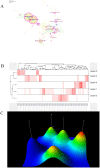Global Trends and Performances of Acupuncture Therapy on Bell's Palsy from 2000 to 2023: A Bibliometric Analysis
- PMID: 37397274
- PMCID: PMC10312334
- DOI: 10.2147/JPR.S401086
Global Trends and Performances of Acupuncture Therapy on Bell's Palsy from 2000 to 2023: A Bibliometric Analysis
Abstract
Purpose: Recent studies have shown that acupuncture may have great potential in the treatment of Bell's palsy. However, the bibliometric analysis of this field has not been summarized properly. Thus, the purpose of this study is to analyze the hotspot of acupuncture for Bell's Palsy.
Methods: The core collection database of Web of Science was searched for relevant publications from 2000 to 2023, and countries, institutions, authors, keywords, and literature were analyzed and visualized by bibliometric softwareCiteSpace 5.1.R6, Vosviewer, BICOMB, and gCLUTO to explore the scientific achievements, research collaboration networks, research hot spots, and research trends.
Results: 229 publications were included in this study. The most cited journal is Journal of Otolaryngology-Head & Neck Surgery; the most prolific country is China; the most prolific author is Li Ying, moreover, the collaboration among scholars is poor; Kyung Hee University is the most prolific institution studying acupuncture for Bell's Palsy. Reference burst detection indicates that traditional Chinese Medicine philosophy, the role of acupuncture in the prognosis of facial palsy, mechanism of acupuncture to improve facial nerve function, and the use of electroacupuncture are starting to become new research hotspots.
Conclusion: The field of acupuncture for Bell's Palsy has developed rapidly in recent years, and new research trends are mainly: combination with traditional Chinese medicine, the role of acupuncture in the prognosis of facial palsy, mechanism of acupuncture to improve facial nerve function, and the use of electroacupuncture. However, research in this field is still dominated by case reports and clinical trials, and there is a lack of large-scale, multicenter clinical trials and animal experiments there are still many problems in institutional cooperation and experimental design, which requires relevant researchers to strengthen cooperation and improve experimental design.
Keywords: Bell’s palsy; CiteSpace; Vosviewer; acupuncture; bibliometric analysis.
© 2023 Yu et al.
Conflict of interest statement
The authors declare that the research was conducted in the absence of any commercial or financial relationships that could be construed as a potential conflict of interest.
Figures








Similar articles
-
Bell's palsy research hotspots and frontiers from 2002 to 2021: a bibliometric and visual analysis.Am J Transl Res. 2023 Jul 15;15(7):4796-4804. eCollection 2023. Am J Transl Res. 2023. PMID: 37560237 Free PMC article.
-
Research Trends of Acupuncture Therapy on Fibromyalgia from 2000 to 2021: A Bibliometric Analysis.J Pain Res. 2022 Dec 15;15:3941-3958. doi: 10.2147/JPR.S382847. eCollection 2022. J Pain Res. 2022. PMID: 36545405 Free PMC article. Review.
-
Effects of acupuncture for Bell's palsy patients in the acute phase and its impact on facial nerve edema: a study protocol for a randomized, controlled trial.Front Neurol. 2024 Apr 16;15:1327206. doi: 10.3389/fneur.2024.1327206. eCollection 2024. Front Neurol. 2024. PMID: 38689877 Free PMC article.
-
Research trends of acupuncture therapy on facial paralysis in a decade spanning 2013-2023: A bibliometric analysis.Complement Ther Med. 2023 Dec;79:103006. doi: 10.1016/j.ctim.2023.103006. Epub 2023 Nov 14. Complement Ther Med. 2023. PMID: 37972694 Review.
-
Effects of electroacupuncture therapy for Bell's palsy from acute stage: study protocol for a randomized controlled trial.Trials. 2015 Aug 25;16:378. doi: 10.1186/s13063-015-0893-9. Trials. 2015. PMID: 26303741 Free PMC article. Clinical Trial.
Cited by
-
Essential Reads in Rhinology: A Bibliometric Analysis.Indian J Otolaryngol Head Neck Surg. 2024 Dec;76(6):5652-5665. doi: 10.1007/s12070-024-05055-2. Epub 2024 Sep 23. Indian J Otolaryngol Head Neck Surg. 2024. PMID: 39559135 Free PMC article.
-
Knowledge and Awareness Regarding Bell's Palsy in the Al-Qassim Region, Saudi Arabia.Cureus. 2023 Dec 30;15(12):e51327. doi: 10.7759/cureus.51327. eCollection 2023 Dec. Cureus. 2023. PMID: 38288216 Free PMC article.
-
Biological effect of acupuncture on peripheral facial paralysis.Front Neurol. 2025 Apr 24;16:1516904. doi: 10.3389/fneur.2025.1516904. eCollection 2025. Front Neurol. 2025. PMID: 40352774 Free PMC article. Review.
-
Progress in treatment of facial neuritis by acupuncture combined with medicine from the perspective of modern medicine: A review.Medicine (Baltimore). 2023 Dec 22;102(51):e36751. doi: 10.1097/MD.0000000000036751. Medicine (Baltimore). 2023. PMID: 38134097 Free PMC article. Review.
-
Knowledge mapping of acupoint sensitization and acupoint specificity: a bibliometric analysis.Front Neurosci. 2023 Nov 20;17:1292478. doi: 10.3389/fnins.2023.1292478. eCollection 2023. Front Neurosci. 2023. PMID: 38053608 Free PMC article.
References
-
- Shannon S, Meadow S, Horowitz SH. Clinical inquiries. Are drug therapies effective in treating Bell’s palsy? J Fam Pract. 2003;52(2):156–159. - PubMed
Publication types
LinkOut - more resources
Full Text Sources

